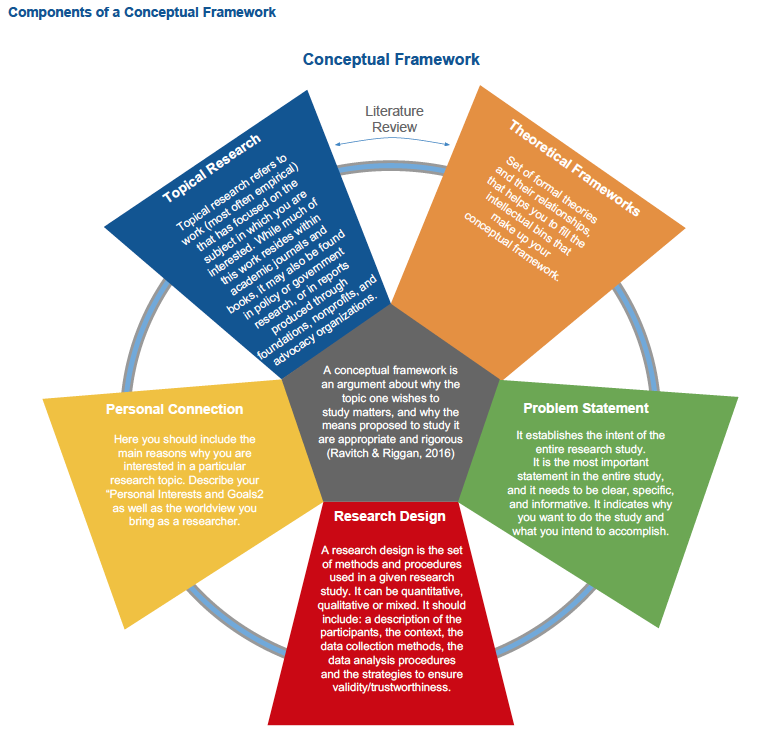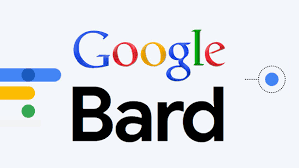Conceptual Framework
- Home /
- Conceptual Framework
![]() This tool will help you generate a visual representation of the key components of the conceptual framework for your dissertation. Please check the tabs on the right side in order to respond the following questions. By the end of the process, you will receive in your email a pdf with different visual representations of your conceptual framework like the one you can see below. Click "Next" to begin the process.
This tool will help you generate a visual representation of the key components of the conceptual framework for your dissertation. Please check the tabs on the right side in order to respond the following questions. By the end of the process, you will receive in your email a pdf with different visual representations of your conceptual framework like the one you can see below. Click "Next" to begin the process.
The conceptual framework of your study is the system of concepts, assumptions, expectations, beliefs, and theories that supports and informs your research. It is a formulation of what you think is going on with what you are studying—a tentative theory of what is happening and why.
Theory provides a model or map of why the world is the way it is (Strauss & Corbin, 1990) The function of theory in your design is to inform the rest of the design. The “research problem” is a part of your conceptual framework, and formulating the research problem is often seen as a key task in designing your study. Ravitch & Riggan (2016) define a conceptual framework as an argument about why the topic one wishes to study matters, and why the means proposed to study it are appropriate and rigorous. By argument, they mean that a conceptual framework is a series of sequenced, logical propositions the purpose of which is to ground the study and convince readers of the study’s importance and rigor. Arguments for why a study “matters” vary greatly in scale, depending on the audience.
In some scholarly work, the study may only matter to a small, esoteric community, but that does not change the fact that its conceptual framework should argue for its relevance within that community. By appropriate and rigorous, they mean that a conceptual framework should argue convincingly that: (a) the research questions are an outgrowth of the argument for relevance; (b) the research design maps onto the study goals, questions, and context(s); (c) the data to be collected provide the researcher with the raw material needed to explore the research questions; and (d) the analytic approach allows the researcher(s) to effectively address (if not always answer) those questions. In order to start building the conceptual framework for your research project we truly recommend the following book:
Ravitch, S. M., & Riggan, M. (2016). Reason & rigor : how conceptual frameworks guide research. Thousand Oaks : Sage Publications. The following figure represents and briefly explains the main components a conceptual framework should have.

The following are questions that Ravitch & Riggan (2016) encourage you to explore in order to engage in a process of self-examination at the outset of your research and then iteratively throughout the research process.
What is interesting to me and why? (In terms of my research topic) What personal and professional motivations do I have for engaging in this research? How might these motivations influence how I think about and approach the topic? What are my beliefs about the people, places, and ideas involved in and related to my study? Where do these beliefs come from? What assumptions underlie these beliefs? What orientations to the topic, setting, and concepts do I have? Where do these ideas come from? What is my sense of the relationship between the macro and micro sociopolitical circumstances in which people make meaning and choices in their lives? With respect to the participants in my study specifically? What is my "agenda" for taking up this topic in this setting at this time? (Having an agenda is not necessarily a bad thing. This may be the foundation of your argument!) What influences this agenda? What biases shape this agenda? How might my guiding agenda contribute, both positively and negatively, to my research design? Implementation? Analysis? Findings? What hunches do I have about what I might find and discover? What informs these hunches? What concerns, hopes, and expectations do I have for this research?
In addition to the responses to these questions, you can also take advantage of the goals defined in the second stage of the Hopscotch. There are three types of goals for doing a study (Maxwell, 2008) that could help you shape your personal connection with the selected research topic:
- Personal goals: those that motivate you to do this study; they can include a desire to change some existing situation, a curiosity about a specific phenomenon or event, or simply the need to advance your career.
- Practical goals: are focused on accomplishing something—meeting some need, changing some situation, or achieving some goal.
- Intellectual goals: re focused on understanding something, gaining some insight into what is going on and why this is happening
This second step is deeply related to the paradigmatic view or worldview that you will be bringing to the study as a researcher. Please have a look at information provided within the first step of Hopscotch (Step 1: Paradigmatic View of the Researcher) in order to understand the particularities of the main worldviews you might bring to your study.
The third and main component of your conceptual framework will be the review of literature. The following guides that have been generated by Dr. Olga Koz, Graduate Librarian at the Bagwell College of Education (Kennesaw State University) could be a great resource when working in the topical research and theoretical frameworks you will use to justify the relevance of your research topic and the need for the study you are proposing:
- Literature Review for a Dissertation: a step-by-step guide
- Databases in education
- How to identify scholarly articles
- Searching for education literature
- Finding Sources
Ravitch & Riggan (2016) propose two different sub-components in your literature review: a) Topical Research and; b) Theoretical Frameworks.
"Topical research refers to previous work (most often empirical) that has focused on the topic in which you are interested. While much of this work resides within academic journals and books, it may also be found in policy or government research, or in reports produced through foundations, nonprofits, and advocacy organizations."
They understand a theoretical framework "as a set of formal theories and their relationships, that helps you to fill the intellectual bins that make up your conceptual framework."
The following resource will be of help to identify topical research and theoretical frameworks to justify the relevance of your research topic, its pertinence and its theoretical roots.
| Resource to generate a visual representation of your Literature review |
This form will help you build a visual representation of the topics emerging from 10 key readings that are deeply related with your research topic. The generated visual will also help you differentiate between the topical research and theoretical frameworks that will serve you to start building the conceptual framework for your research project. After filling out the form you will receive an email including a pdf document with a visual representation of the work done, as well as a link for you to modify your answers as many times as needed. In the following link you can see an example of the type of document you will get after filling out the form: goo.gl/TL9hsg The visual representation generated will help you build the literature review for your research project. To identify the 10 articles which are most related to your research topic, or that inform your conceptual framework, you will have to read many more than 10. All articles must be primary sources and from peer-reviewed/refereed journals. To do so you can use any of the resources that we have included in the tables below (Resource to identify key topics in your field of research: Open Knowledge Map; Resource to graphically build your conceptual framework; Research guides; Science of Science (Sci2)). You don´t have to use all of the resources provided, just the ones you believe could help you the most based on your previous knowledge. For instance, if you already know how to conduct a literature review, or how to identify scholarly articles, you might not have to use the "Research Guides." On the contrary, if you want to identify existing publications regarding your research topic, you might want to use the "Databases in Education," and "Open Knowledge Maps." The following figure shows an example of the type of visual representation you will get after filling out the form.  |
| Resource to identify key topics in your field of research: Open Knowledge Map |
With "Open Knowledge Maps" you will be able to search for key concepts related to your research topic in order to generate a visual representation that will help you identify publications addressing that particular key concept.  |
| Resource to identify key literature in your field of research: Science of Science (Sci2) |
The Science of Science (Sci2) Tool is a modular toolset specifically designed for the study of science. It supports the temporal, geospatial, topical, and network analysis and visualization of scholarly datasets at the micro (individual), meso (local), and macro (global) levels. This tool can be used to conduct thorough literature reviews.  |
| Resource: Research Guides |
 The following guides that have been generated by Dr. Olga Koz, Graduate Librarian at the Bagwell College of Education (Kennesaw State University) could be a great resource when working in the topical research and theoretical frameworks you will use to justify the relevance of your research topic and the need for the study you are proposing: The following guides that have been generated by Dr. Olga Koz, Graduate Librarian at the Bagwell College of Education (Kennesaw State University) could be a great resource when working in the topical research and theoretical frameworks you will use to justify the relevance of your research topic and the need for the study you are proposing: |
| Resource to Define your problem statement |
| One key component of your conceptual framework will be the "Problem Statement." You can use this template to define it after having conducted your review of literature. |
| Resource to graphically build your conceptual framework |
You can use this template to create a visual representation of the main components that should be included in the conceptual framework of your research project. In order to be able to use the template, you will have to log in your Google account so the system can ask you to make a copy of it.  |



